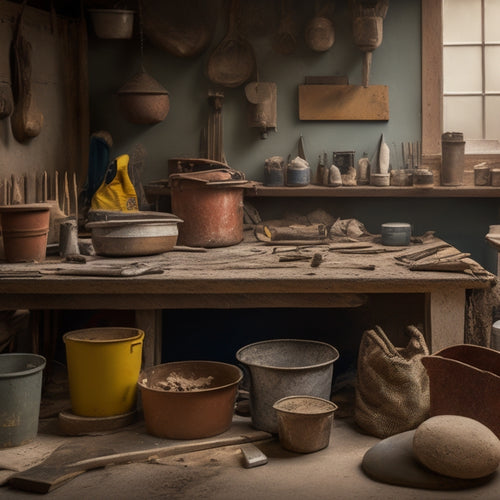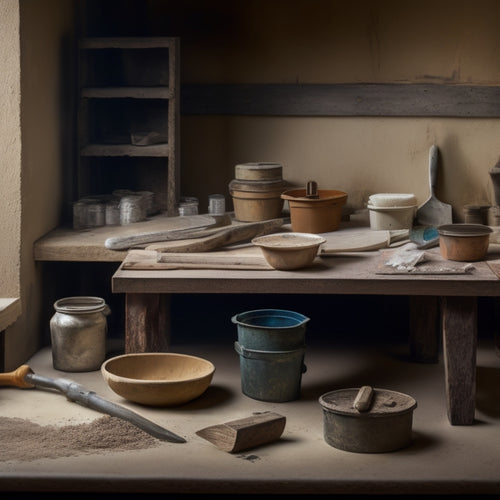
Top Edger Tools for Interior Home Renovation Projects
Share
As you prepare to tackle your interior home renovation project, selecting the right edger tool is essential for achieving flawless edges and precise cuts. You'll want to take into account factors like project type, precision vs. speed, and comfort during prolonged use. Top electric edgers like Bosch, Makita, and Hitachi offer powerful motors and adjustable handles for comfort. Gas-powered edgers provide superior power for larger areas, while manual edgers allow for meticulous shaping and refining. With the right edger, you'll be able to achieve clean, precise cuts and smooth edges that elevate your renovation project - and we'll show you how to make the perfect cut.
Key Takeaways
• Consider project type, size, and desired edge style when selecting the right edger tool for interior home renovation projects.
• Electric edgers offer consistent power and ease of use, while gas-powered edgers provide higher performance for larger, tougher jobs.
• Manual edgers are eco-friendly and suitable for small, detailed tasks, and multi-functional tools combine edging with other landscaping capabilities.
• Blade material and cutting angle considerations are crucial for achieving clean, precise cuts and smooth, curved edges.
• Safety features, such as protective guards and ergonomic design, are essential for reducing the risk of accidents and injuries during edger tool operation.
Selecting the Right Concrete Edger
As you stand in front of the rows of concrete edgers at the hardware store, you're faced with an intimidating task: choosing the perfect tool to create clean, defined edges that will elevate your home renovation project from ordinary to exceptional.
The right concrete edger can make all the difference in achieving a polished, professional look.
When selecting a concrete edger, consider the type of project you're working on and the specific concrete edging techniques you'll need to employ. For instance, if you're looking to create a seamless landscape integration, you'll want an edger that can handle curved or irregular shapes.
Think about the size and scope of your project, as well as the type of concrete you're working with. Will you need a manual or powered edger? Do you prioritize precision or speed?
Top Electric Concrete Edgers
With your project's specific needs in mind, you're now ready to explore the top electric concrete edgers that will bring your vision to life with precision and power.
Electric concrete edgers offer numerous benefits, including reduced fatigue, increased efficiency, and improved accuracy. When it comes to concrete edging techniques, electric edgers provide unparalleled control, allowing you to achieve clean, precise cuts and smooth, curved edges.
Some top electric concrete edgers include the Bosch 1800W Electric Edger, which boasts a powerful motor and adjustable handle for comfortable operation.
The Makita 1600W Electric Edger is another popular choice, featuring a compact design and variable speed control for added versatility.
For more intricate projects, the Hitachi 1400W Electric Edger is a great option, with its ergonomic grip and adjustable depth guide for precise control.
Regardless of your project's scope, these top electric concrete edgers will help you achieve professional-grade results with ease.
Gas Powered Edger Reviews
As you scan the market for the perfect gas powered edger, you're likely looking for a tool that packs a punch regarding power and performance.
You want an edger that can tackle tough jobs with ease, leaving your outdoor spaces looking crisp and clean.
When it comes to making your decision, consider how important ease of operation is to you - will you prioritize a lightweight, ergonomic design or a robust engine that can handle heavy-duty tasks?
Power and Performance
You'll immediately notice the raw power of gas-powered edgers, which release a torrent of energy to slice through even the toughest overgrowth and leave your lawn edges looking razor-sharp.
As you rev up the engine, the edger's blade begins to whirl at incredible speeds, effortlessly cutting through thick weeds and grass. When it comes to power efficiency, gas-powered edgers are hard to beat. They provide a significant boost in performance compared to their electric counterparts, allowing you to tackle larger areas in less time.
When making a performance comparison between different gas-powered edgers, consider the engine displacement, horsepower, and blade speed. Look for edgers with high-performance engines that can handle demanding tasks with ease.
A higher blade speed will give you a cleaner cut and reduce the risk of leaving behind unsightly grass clippings. With the right gas-powered edger, you'll be able to achieve professional-looking results with minimal effort, making it an essential tool for any interior home renovation project.
Ease of Operation
Four key design elements - adjustable handles, comfortable grips, intuitive controls, and a well-balanced chassis - come together to make gas-powered edgers a breeze to operate, even for extended periods of time.
As you take hold of the ergonomic grips, you'll notice how naturally your hands fit, allowing you to maintain control and precision.
The user-friendly designs guarantee that you can focus on the task at hand, rather than struggling with the tool itself.
Here are three key benefits you'll experience with gas-powered edgers that prioritize ease of operation:
-
Reduced fatigue: With adjustable handles and a well-balanced chassis, you'll be able to work for longer periods without feeling exhausted.
-
Improved precision: Intuitive controls and comfortable grips enable you to make precise cuts and maintain control, even in tight spaces.
-
Enhanced productivity: With a tool that's easy to operate, you'll be able to complete tasks quickly and efficiently, allowing you to tackle more projects in less time.
Manual Concrete Edger Options
With a focus on precision and control, manual concrete edgers put you in the driver's seat, allowing you to meticulously shape and refine concrete edges by hand. This hands-on approach enables you to master manual edging techniques, ensuring a flawless finish that elevates your interior home renovation project. By honing your skills in concrete finishing tips, you'll be able to create crisp, clean edges that define the space.
Here's a comparison of popular manual concrete edger options:
| Edger Type | Edge Profile | Best For |
|---|---|---|
| Tamping Edger | Sleek, flat edges | Large, open spaces |
| Radius Edger | Smooth, curved edges | Circular or rounded features |
| Step Edger | Defined, stepped edges | Staircases, ledges, or multi-level spaces |
When choosing a manual concrete edger, consider the specific demands of your project and the level of precision you need to achieve. By selecting the right tool for the job, you'll be able to unleash the full potential of your concrete edges and create a stunning, professional-grade finish.
Edger Blade Selection Guide
As you step into the world of edger blades, you're faced with a multitude of options that can make or break the success of your home renovation project.
You'll want to scrutinize the blade material, considering factors like durability, rust resistance, and edge retention to guarantee a precise cut every time.
Blade Material Options
When selecting the perfect edger blade for your home renovation project, you'll encounter a variety of blade material options, each boasting distinct characteristics that greatly impact performance, durability, and overall results.
As you navigate the market, consider the following blade material options that cater to your specific needs:
-
High-Carbon Steel (HCS) Blades: Known for their blade durability, HCS blades are ideal for heavy-duty use on hardwoods and other dense materials. They offer excellent wear resistance and can withstand high temperatures.
-
Tungsten Carbide-Tipped (TCT) Blades: TCT blades excel in blade compatibility, working seamlessly with various edger tools. They provide superior cutting performance and extended lifespan, making them perfect for large-scale projects.
-
Diamond-Coated Blades: These blades are designed for specialized tasks, such as cutting through tile, concrete, or stone. They offer unparalleled durability and precision, ensuring a smooth finish.
Cutting Angle Control
Set your edger tool to the ideal cutting angle, and you'll release the full potential of your blade, ensuring precise cuts, reduced wear, and a professional-looking finish. Achieving the perfect angle adjustment is essential for cutting precision, as it allows you to navigate intricate designs and patterns with ease.
When selecting an edger tool, look for one with an adjustable angle feature, allowing you to customize the blade's position to suit your project's specific needs. For instance, a 20-degree angle is ideal for creating sharp, defined edges, while a 45-degree angle is better suited for beveling and chamfering.
Some edger tools even offer a variable angle adjustment, giving you the flexibility to adapt to changing project requirements. By mastering the art of cutting angle control, you'll be able to tackle complex renovation projects with confidence, producing results that are both visually stunning and technically impressive.
Safety Features to Consider
What safety features do you prioritize when selecting an edger tool for your home renovation project, considering the potential hazards that can come with operating such equipment?
As you navigate the world of edger tools, it's crucial to keep safety top of mind. After all, a single misstep can lead to serious injury or even long-term damage.
When evaluating edger tools, consider the following safety features:
-
Protective guards: Look for tools with sturdy guards that prevent accidental contact with the blade or other moving parts.
-
Ergonomic design: Opt for tools with comfortable, cushioned grips and balanced weight distribution to reduce fatigue and strain.
-
Safety gear integration: Consider tools that allow for easy integration with personal protective equipment (PPE) like safety glasses, ear protection, and dust masks.
Edger Tool Maintenance Tips
Properly maintaining your edger tool is essential to extending its lifespan, ensuring peak performance, and preventing accidents.
Take the time to regularly inspect and clean the blade, checking for signs of wear and tear, rust, or corrosion. A dull or damaged blade can lead to uneven cuts, increased vibration, and even accidents, so it's vital to address any issues promptly.
When storing your edger tool, choose a dry, well-ventilated area away from direct sunlight and moisture. Clean the tool thoroughly before storage, and consider applying a rust-inhibiting coating to protect the metal components.
In addition to regular cleaning and storage, consider seasonal maintenance to keep your edger tool in prime condition. At the start of each new season, inspect the tool's cord or battery, checking for signs of wear or damage.
Perform any necessary repairs or replacements before diving into your next project. By following these simple maintenance tips, you'll be able to enjoy optimal performance and safety from your edger tool, ensuring a successful and stress-free renovation project.
Frequently Asked Questions
Can I Use a Concrete Edger on Freshly Poured Concrete?
When working with fresh concrete, you'll want to wait until it's set enough to hold its shape before using an edger, as improper edging techniques can mar the surface, ruining the aesthetic you're aiming for.
How Do I Store My Edger Tool When Not in Use?
When you're not using your edger tool, you'll want to store it properly to maintain its performance and extend its lifespan. Clean and dry it thoroughly, then store it in a protective case or hang it from a hook to prevent damage.
Are Concrete Edgers Suitable for Outdoor Landscaping Projects?
Imagine a beautifully manicured garden, where clean lines and defined edges create a visual masterpiece. When you're working on outdoor landscaping projects, you'll find that concrete edgers are a great choice, offering benefits like durability and versatility, but consider the project's scale and soil type before making a decision.
Can I Use a Concrete Edger on Other Materials Like Asphalt or Wood?
You'll find that a concrete edger's compatibility is limited to its namesake material; it's not suitable for asphalt or wood, as the tool's design and blades are material-specific, making it less effective on other surfaces.
Are Edger Tools Typically Included in a Contractor's Warranty?
As you navigate the renovation landscape, you'll find that edger tools are rarely covered under a contractor's warranty, leaving you to scrutinize the fine print and understand what's included in their warranty coverage, and what responsibilities fall on the contractor's shoulders.
Conclusion
As you put the finishing touches on your interior home renovation project, remember that the devil is in the details - and a high-quality concrete edger is the unsung hero that brings it all together.
With the right tool in hand, your floors will shine like a work of art, and your space will transform into a masterpiece.
By choosing the perfect edger, you'll be the conductor of a symphony of style, orchestrating a harmonious blend of form and function.
Related Posts
-

What Plastering Tools Do You Need for Renovation
You'll need a range of specialized tools to tackle a plastering renovation project efficiently and effectively. Essen...
-

Top 5 Plastering Tools for Small Renovation Jobs
For small renovation jobs, you'll want to start with the top 5 crucial plastering tools: a putty knife for applying a...
-

3 Best Planter Shopping Timeline Tips for Renovators
When incorporating planters into your renovation project, you'll want to plan carefully to avoid delays and guarantee...


